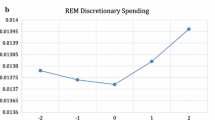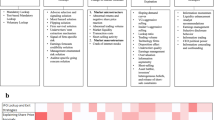Abstract
A lock-up agreement is an arrangement between the underwriter and certain pre-IPO shareholders. This paper examines the influence of an underwriter’s early lock-up release on shareholder wealth. The study found significant negative abnormal returns associated with the early lock-up release annoucement. Negative abnormal returns are more pronounced for venture capital backed firms than for firms not venture capital backed. In addition, scheduled lock-up release day abnormal returns, found in previous studies to be significantly negative, are reduced for firms announcing the early lock-up release.(JEL G24, G30)
Similar content being viewed by others
References
Barry, B., C. Muscarella, J. Peavy, and M. Vestsuypens. 1990. “The Role of Venture Capital in the Creation of Public Companies.”Journal of Financial Economics 27: 447–471.
Bettis, J. C., Bizjak, J. M., and Lemmon, M. L. 2001. “Insider Trading in Derivative Securities: An Empirical Examination of the Use of Zero-Cost Collars and Equity Swaps by Corporate Insiders.” Forthcoming.Journal of Financial and Quantitative Analysis.
Bradley, D., B. Jordan, I. Rotan, and H. Yi. 2001. “Venture Capital and IPO Lockup Expiration: An Empirical Analysis.” Forthcoming.Journal of Financial Research.
Brav, A., and P. Gompers. 2000. “Insider Trading Subsequent to Initial Public Offerings: Evidence from Expirations of Lock-Up Provisions.” Unpublished Working Paper, Duke University, Harvard University.
Brau, J., and G. McQueen. 2000. “IPO Lockups: A Signaling Solution to an Adverse Selection Problem.” Unpublished Working Paper, Brigham Young University.
Brown, S., and J. Warner, 1985. “Using Daily Stock Returns: The Case of Event Studies.”Journal of Financial Economics 14: 3–31.
Field, L., and G. Hanka. 2001. “The Expiration of IPO Share Lockups.”Journal of Finance 56: 471–500.
Julius, M. 1997. “Delayed Liquidity for Sellers Receiving Restricted Shares.”Mergers and Acquisitions 31: 36–38.
Keasler, T. R. 2001. “Underwriter Lock-up Releases, Initial Public Offerings and After-Market Performance”.The Financial Review 37: 1–20.
Leland, H., and D. Pyle. 1977. “Information Asymmetries, Financial Structure, and Financial Intermediation”.Journal of Finance 32: 371–387.
Longstaff, F. 1995. “How Much Can Marketability Affect Security Values”.Journal of Finance 50: 1767–1774.
Mikkelson, W., and M. Partch. 1988. “Withdrawn Security Offerings”.Journal of Financial and Quantitative Analysis 23: 119–134.
O’Conner, D. 1995. “For Best Underwriting, Pick the Right Issues to Negotiate”.Corporate Cashflow 14: 24–25.
Odean, T. 1996. “Are Investors Reluctant to Realize Their Losses?”Journal of Finance 53: 1775–1798.
Ofek, E., and M. Richardson. 2000. “The IPO Lock-Up Period: Implications for Market Efficiency and Downward Sloping Demand Curve.” Unpublished Working Paper, New York University.
Sanger and Peterson. 1990. “An Empirical Analysis of Common Stock Delistings”.Journal of Financial and Quantitative Analysis 25: 261–272.
Scholes, M., and J. Williams. 1977. “Estimating Betas from Nonsynchronous Data”.Journal of Financial Economics 5: 309–327.
Shefrin, H., and M. Statman. 1985. “The Disposition to Sell Winners Too Early and Ride Losers Too Long: Theory and Evidence”.Journal of Finance 40: 777–790.
Author information
Authors and Affiliations
Rights and permissions
About this article
Cite this article
Keasler, T.R. The underwriter’s early lock-up release: Empirical evidence. J Econ Finan 25, 214–228 (2001). https://doi.org/10.1007/BF02744524
Issue Date:
DOI: https://doi.org/10.1007/BF02744524




